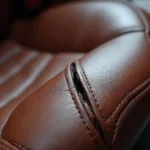Leather car seats exude luxury and class, but they’re not immune to the occasional mishap. A small hole can be an eyesore, diminishing the overall aesthetic appeal of your car’s interior. Fortunately, you don’t need to be an automotive expert to tackle this issue. With a little patience and the right materials, you can learn how to repair small hole in leather car seat and restore its former glory.
Understanding the Damage
Before diving into the repair, it’s crucial to assess the extent of the damage. A small hole is typically considered anything less than 1/2 inch in diameter. If the hole is larger or you’re dealing with a rip or tear, more advanced techniques might be required.
Gathering Your Supplies
To successfully repair a small hole in your leather car seat, you’ll need a few essential supplies:
- Leather repair kit: These kits are widely available online and at auto parts stores. Look for a kit that matches the color of your leather as closely as possible.
- Scissors: For trimming any loose threads or material.
- Rubbing alcohol: To clean the area around the hole.
- Cotton swabs: For applying rubbing alcohol and adhesive.
- Hairdryer (optional): To speed up the drying process.
Step-by-Step Repair Guide
Follow these steps to effectively repair the hole in your leather car seat:
-
Clean the area: Using a cotton swab dipped in rubbing alcohol, gently clean the area around the hole. This will remove any dirt, debris, or oils that could prevent the adhesive from bonding properly.
-
Prepare the repair patch: Most leather repair kits include a backing fabric to provide support for the repair compound. Cut a piece of backing fabric slightly larger than the hole.
-
Apply the adhesive: Following the instructions on your leather repair kit, apply a thin layer of adhesive to the back of the repair patch and around the edges of the hole in the leather.
-
Position the patch: Carefully place the repair patch over the hole, ensuring it lays flat and smooth against the leather. Gently press down on the patch to secure it in place.
-
Apply the filler compound: Using a palette knife or similar tool, carefully apply the leather filler compound over the patch, ensuring the hole is completely filled and the compound blends seamlessly with the surrounding leather.
-
Allow to dry: Let the filler compound dry completely according to the manufacturer’s instructions. You can use a hairdryer on a low setting to speed up the drying time, but be careful not to overheat the leather.
-
Sand and blend: Once the filler compound is dry, use fine-grit sandpaper to gently smooth out any rough edges and blend the repair with the surrounding leather.
-
Apply colorant (if necessary): If your leather repair kit includes a colorant, use a sponge or brush to apply it to the repaired area, following the manufacturer’s instructions for the best results.
-
Apply leather conditioner: After the repair is complete and the colorant (if used) is dry, apply a leather conditioner to the entire seat to restore its natural softness and shine.
Maintaining Your Repaired Seat
To keep your leather car seats looking their best after the repair:
- Clean your seats regularly with a leather cleaner and conditioner.
- Avoid parking in direct sunlight for prolonged periods, as this can cause the leather to fade and crack.
- Address spills and stains immediately to prevent them from setting into the leather.
By following these tips, you can enjoy your like-new leather car seats for years to come.
Frequently Asked Questions
Q: Can I use super glue to repair a small hole in my leather car seat?
A: While it might seem like a quick fix, using super glue is not recommended. Super glue is too harsh for leather and can cause further damage, making professional repair more difficult and costly.
Q: How much does it cost to professionally repair a small hole in a leather car seat?
A: The cost of professional repair can vary depending on the size and location of the damage, as well as the type of leather. However, you can expect to pay anywhere from $50 to $150 for a small hole repair.
Q: Can I prevent holes from happening in my leather car seats?
A: While it’s impossible to prevent all accidents, you can minimize the risk by being mindful of sharp objects, keeping your pets properly secured in the backseat, and regularly inspecting your seats for any signs of wear and tear.
Need More Help?
For more comprehensive guides on car seat repair, check out these helpful resources:
- How to repair a rip in a leather car seat
- How to repair a tear in my car seat
- How to repair a seam on a leather car seat
- How to repair torn cloth car seats
Remember, a small hole doesn’t have to mean the end for your leather car seat. With a bit of effort and the right approach, you can easily repair the damage and restore your car’s interior to its former glory. If you’re unsure about tackling the repair yourself, don’t hesitate to seek help from a professional automotive upholstery specialist.


